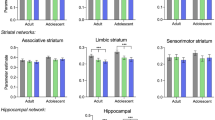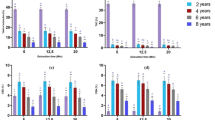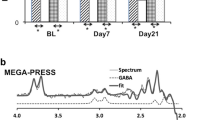Abstract
There are no FDA-approved pharmacotherapies for cannabis dependence. Cannabis is the most widely used illicit drug in the world, and patients seeking treatment for primary cannabis dependence represent 25% of all substance use admissions. We conducted a phase IIa proof-of-concept pilot study to examine the safety and efficacy of a calcium channel/GABA modulating drug, gabapentin, for the treatment of cannabis dependence. A 12-week, randomized, double-blind, placebo-controlled clinical trial was conducted in 50 unpaid treatment-seeking male and female outpatients, aged 18–65 years, diagnosed with current cannabis dependence. Subjects received either gabapentin (1200 mg/day) or matched placebo. Manual-guided, abstinence-oriented individual counseling was provided weekly to all participants. Cannabis use was measured by weekly urine toxicology and by self-report using the Timeline Followback Interview. Cannabis withdrawal symptoms were assessed using the Marijuana Withdrawal Checklist. Executive function was measured using subtests from the Delis–Kaplan Executive Function System. Relative to placebo, gabapentin significantly reduced cannabis use as measured both by urine toxicology (p=0.001) and by the Timeline Followback Interview (p=0.004), and significantly decreased withdrawal symptoms as measured by the Marijuana Withdrawal Checklist (p<0.001). Gabapentin was also associated with significantly greater improvement in overall performance on tests of executive function (p=0.029). This POC pilot study provides preliminary support for the safety and efficacy of gabapentin for treatment of cannabis dependence that merits further study, and provides an alternative conceptual framework for treatment of addiction aimed at restoring homeostasis in brain stress systems that are dysregulated in drug dependence and withdrawal.
Similar content being viewed by others
Log in or create a free account to read this content
Gain free access to this article, as well as selected content from this journal and more on nature.com
or
References
American Psychiatric Association (2000). Diagnostic and Statistical Manual of Mental Disorders, 4th edn, Text Revision. American Psychiatric Press: Washington, DC.
Beck AT, Steer RA, Ball R, Ranieri W (1996). Comparison of beck depression inventories -IA and -II in psychiatric outpatients. J Pers Assess 67: 588–597.
Bolla KI, Lesage SR, Gamaldo CE, Neubauer DN, Wang NY, Funderburk FR et al (2010). Polysomnogram changes in marijuana users who report sleep disturbances during prior abstinence. Sleep Med 11: 882–889.
Budney AJ, Moore BA, Vandrey RG, Hughes JR (2003). The time course and significance of cannabis withdrawal. J Abnorm Psychol 112: 393–402.
Budney AJ, Novy PL, Hughes JR (1999). Marijuana withdrawal among adults seeking treatment for marijuana dependence. Addiction 94: 1311–1322.
Budney AJ, Vandrey RG, Hughes JR, Thostenson JD, Bursac Z (2008). Comparison of cannabis and tobacco withdrawal: severity and contribution to relapse. J Subst Abuse Treat 35: 362–368.
Buysse DJ, Reynolds 3rd CF, Monk TH, Berman SR, Kupfer DJ (1989). The Pittsburgh sleep quality index: a new instrument for psychiatric practice and research. Psychiatry Res 28: 193–213.
Caravati EM (2003). Marijuana and other cannabinoids. In: Dart RC (ed). Medical Toxicology, 3rd edn. Lippincott Williams & Wilkins: Philadelphia, PA.
Carpenter KM, McDowell D, Brooks DJ, Cheng WY, Levin FR (2009). A preliminary trial: double-blind comparison of nefazodone, bupropion-SR, and placebo in the treatment of cannabis dependence. Am J Addict 18: 53–64.
Copersino ML, Boyd SJ, Tashkin DP, Huestis MA, Heishman SJ, Dermand JC et al (2006). Cannabis withdrawal among non-treatment-seeking adult cannabis users. Am J Addict 15: 8–14.
Crean RD, Crane NA, Mason BJ (2011). An evidence based review of acute and long-term effects of cannabis use on executive cognitive functions. J Addict Med 5: 1–8.
Delis D, Kramer J, Kaplan E (2001). Manual for the Delis-Kaplan Executive Function System (D-KEFS). Psychological Corporation: San Antonio, TX.
Donovan DM, Bigelow GE, Brigham GS, Carroll KM, Cohen AJ, Gardin JG et al (2011). Primary outcome indices in illicit drug dependence treatment research: systematic approach to selection and measurement of drug use end-points in clinical trials. Addiction (e-pub ahead of print).
Fals-Stewart W, O’Farrell TJ, Freitas TT, McFarlin SK, Rutigliano P (2000). The timeline followback reports of psychoactive substance use by drug-abusing patients: psychometric properties. J Consult Clin Psychol 68: 134–144.
Fraser AD, Worth D (1999). Urinary excretion profiles of 11-nor-9-carboxy-delta9 tetrahydrocannabinol: a delta9-THCCOOH to creatinine ratio study. J Anal Toxicol 23: 531–534.
Ghaemi SN, Katzow JJ, Desai SP, Goodwin FK (1998). Gabapentin treatment of mood disorders: a preliminary study. J Clin Psy 59: 426–429.
Goldstein RZ, Volkow ND (2002). Drug addiction and its underlying neurobiological basis: neuroimaging evidence for the involvement of the frontal cortex. Am J Psychiatry 159: 1642–1652.
Gueorguieva R, Krystal JH (2004). Move over ANOVA: progress in analyzing repeated- measures data and its reflection in papers published in the Archives of General Psychiatry. Arch Gen Psychiatry 61: 310–317.
Harden CL, Lazar LM, Pick LH, Nikolov B, Goldstein MA, Carson D et al (1999). A beneficial effect on mood in partial epilepsy patients treated with gabapentin. Epilepsia 40: 1129–1134.
Huestis MA, Cone EJ (1998). Differentiating new marijuana use from residual drug excretion in occasional marijuana users. J Anal Toxicol 22: 445–454.
Karam-Hage M, Brower KJ (2000). Gabapentin treatment for insomnia associated with alcohol dependence. Am J Psy 157: 151.
Koob GF, Kandel DB, Volkow ND (2008). Psychiatric pathophysiology: addiction. In: Tasman A, Kay J, Lieberman J, First MB, Maj M (eds). Psychiatry, 3rd edn. John Wiley & Sons: West Sussex, England.
Koob GF, Le Moal M (2005). Plasticity of reward neurocircuitry and the ‘dark side’ of drug addiction. Nature Neurosci 8: 1442–1444.
Koob GF, Le Moal M (2008). Addiction and the brain antireward system. Annu Rev Psychol 59: 29–53.
Koob GF, Volkow ND (2010). Neurocircuitry of addiction. Neuropsychopharmacology 35: 217.
Laird NM, Ware JH (1982). Random-effects models for longitudinal data. Biometrics 38: 963–974.
Levin FR, Mariani JJ, Brooks DJ, Pavlicova M, Cheng W, Nunes EV (2011). Dronabinol for the treatment of cannabis dependence: a randomized, double-blind, placebo-controlled trial. Drug Alcohol Depend 116: 142–150.
Levin FR, McDowell D, Evans SM, Nunes E, Akerele E, Donovan S et al (2004). Pharmacotherapy for marijuana dependence: a double-blind, placebo-controlled pilot study of divalproex sodium. Am J Addict 13: 21–32.
Levine J, Schooler NR (1986). SAFTEE: a technique for the systematic assessment of side effects in clinical trials. Psychopharmacol Bull 22: 343–381.
Lo HS, Yang CM, Lo HG, Lee CY, Ting H, Tzang BS (2010). Treatment effects of gabapentin for primary insomnia. Clin Neuropharmacol 33: 84–90.
Maldonado R, Berrendero F, Ozaita A, Robledo P (2011). Neurochemical basis of cannabis addiction. Neuroscience 181: 1–17.
Mason BJ, Light JM, Williams LD, Drobes DJ (2009). Proof-of-concept human laboratory study for protracted abstinence in alcohol dependence: effects of gabapentin. Addict Biol 14: 73–83.
McRae-Clark AL, Carter RE, Killeen TK, Carpenter MJ, Wahlquist AE, Simpson SA et al (2009). A placebo-controlled trial of buspirone for the treatment of marijuana dependence. Drug Alcohol Depend 105: 132–138.
McRae-Clark AL, Carter RE, Killeen TK, Carpenter MJ, White KG, Brady KT (2010). A placebo-controlled trial of atomoxetine in marijuana-dependent individuals with attention deficit hyperactivity disorder. Am J Addict 19: 481–489.
Neurontin (gabapentin) [package insert LAB-0106-9.0]. Pfizer, New York. Revised January 2007.
Nordstrom BR, Levin FR (2007). Treatment of cannabis use disorders: a review of the literature. Am J Addict 16: 331–342.
Norusis MJ (2008). SPSS Statistics 17.0 Advanced Statistical Procedures Companion. Prentice Hall Inc.: Upper Saddle River, NJ.
Roberto M, Gilpin NW, O’Dell LE, Cruz MT, Morse AC, Siggins GR et al (2008). Cellular and behavioral interactions of gabapentin with alcohol dependence. J Neurosci 28: 5762–5771.
Rodriguez de Fonseca F, Carrera MR, Navarro M, Koob GF, Weiss F (1997). Activation of corticotropin-releasing factor in the limbic system during cannabinoid withdrawal. Science 276: 2050–2054.
Salinsky MC, Storzbach D, Spencer DC, Oken BS, Landry T, Dodrill CB (2005). Effects of topiramate and gabapentin on cognitive abilities in healthy volunteers. Neurology 64: 792–798.
Sills GJ (2006). The mechanisms of action of gabapentin and pregabalin. Curr Opin Pharmacol 6: 108–113.
Smith ML, Barnes AJ, Huestis MA (2009). Identifying new cannabis use with urine creatinine- normalized THCCOOH concentrations and time intervals between specimen collections. J Anal Toxicol 33: 185–189.
Sofuoglu M, Sugarman DE, Carroll KM (2010). Cognitive function as an emerging treatment target for marijuana addiction. Exp Clin Psychopharmacol 18: 109–119.
Stephens RS, Roffman RA, Curtin L (2000). Comparison of extended vs brief treatments for marijuana use. J Consult Clin Psychol 68: 898–908.
Substance Abuse and Mental Health Services Administration (2007). Results from the 2006 National Survey on Drug Use and Health: National Findings (Office of Applied Studies, NSDUH Series H-32, DHHS Publication No. SMA 07-4293). SAMHSA: Rockville, MD.
United Nations Office on Drugs and Crime (2010). World Drug Report 2010. United Nations: New York, NY.
West BT (2009). Analyzing longitudinal data with the linear mixed models procedure in SPSS. Eval Health Prof 32: 207–228.
Wilkinson GS, Robertson GJ (2006). Wide Range Achievement Test-4 Professional Manual. Psychological Assessment Resources, Inc: Lutz, FL.
Xue X, Gange SJ, Zhong Y, Burk RD, Minkoff H, Massad LS et al (2010). Marginal and mixed-effects models in the analysis of human papillomavirus natural history data. Cancer Epidemiol Biomarkers Prev 19: 159–169.
Acknowledgements
This project was funded by National Institute of Drug Abuse grants DA020766 and DA024194.
Author information
Authors and Affiliations
Corresponding author
Ethics declarations
Competing interests
Dr Mason's work is funded by the National Institutes of Health. Over the past 3 years, she has received compensation as a member of the scientific advisory board for Addex Pharmaceuticals and the Lohocla Research Corporation, and as a consultant for Johnson and Johnson Pharmaceutical Research and Development, LLC; Lilly USA, LLC; and Merck Serono. A patent has been filed based in part on this work. The other authors declare no conflict of interest.
Additional information
Supplementary Information accompanies the paper on the Neuropsychopharmacology website
Rights and permissions
About this article
Cite this article
Mason, B., Crean, R., Goodell, V. et al. A Proof-of-Concept Randomized Controlled Study of Gabapentin: Effects on Cannabis Use, Withdrawal and Executive Function Deficits in Cannabis-Dependent Adults. Neuropsychopharmacol 37, 1689–1698 (2012). https://doi.org/10.1038/npp.2012.14
Received:
Revised:
Accepted:
Published:
Issue date:
DOI: https://doi.org/10.1038/npp.2012.14
Keywords
This article is cited by
-
Addiction and Liver Disease: Exploring the Complex Relationship and Implications for Clinical Management
Current Hepatology Reports (2024)
-
Effect of four-week cannabidiol treatment on cognitive function: secondary outcomes from a randomised clinical trial for the treatment of cannabis use disorder
Psychopharmacology (2023)
-
Consideration of sex and gender differences in addiction medication response
Biology of Sex Differences (2022)
-
Cannabinoid hyperemesis syndrome and cannabis withdrawal syndrome: a review of the management of cannabis-related syndrome in the emergency department
International Journal of Emergency Medicine (2022)
-
Helpful or Harmful? The Therapeutic Potential of Medications with Varying Degrees of Abuse Liability in the Treatment of Substance Use Disorders
Current Addiction Reports (2022)



